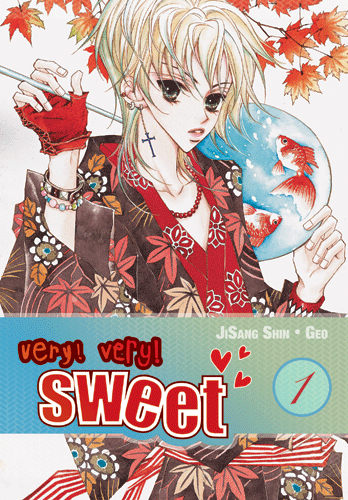 Very! Very! Sweet, vols. 1 and 2
Very! Very! Sweet, vols. 1 and 2
By JiSang Shin and Geo
Rated T for Teen
Yen Press, $10.99
Very! Very! Sweet is a manhwa for readers who have taken off the training wheels: With witty dialogue, nice art, and lots of Korean puns and cultural references, it’s a bit more challenging than your standard schoolgirl manhwa. I honestly wasn’t a fan of this creative team’s other works, Chocolat and Rolling, but I found this manhwa to be quirky, fun, and very readable.
Be-Ri, the lead character, is cheerful and plucky but reasonably three-dimensional. She’s a budding inventor who builds things out of junk and sells them on the internet to help with the family finances. Her widowed mother also rents out a room to make ends meet. With dubious ethics, Mom put a picture of her lovely daughter—Be-Ri’s older sister—in the ad for the spare room, and sure enough, their boarder, Oppa, fell for her. Unfortunately, Be-Ri has a crush on Oppa as well, although she battles to hide it.
The male lead is a Japanese boy named Tsuyoshi, the scion of a pickle empire whose irresponsible ways get him in hot water with his strict grandfather. Grandpa tells Tsuyoshi the family secret, that they came from Korea four generations back, and then packs him off to Japan to return to his roots and mend his errant ways.
Naturally, Tsuyoshi ends up living next to Be-Ri. And just as predictably, they hate each other almost at first sight. What’s interesting about this series is that it’s the boy who is at a disadvantage. Tsuyoshi doesn’t speak Korean very well, and his Korean name (chosen for him by his grandfather) is the word for “yellow pickle,” which the Koreans all find hilarious. Even worse, almost everything he says is misunderstood, especially by Be-Ri, who thinks he is much snottier than he actually is. By volume 2, the relationship has begun to thaw a bit, as Be-Ri realizes how lost Tsuyoshi really is and takes him under her wing a bit.
The second volume establishes the standard manga freeze-thaw-freeze relationship cycle: Be-Ri and Tsuyoshi start to get along, and then something happens and one of them gets mad at the other. Ironically, their classmate Mi-Hyuk is pursuing Be-Ri with a carefully thought-out strategy straight out of shoujo manga: Become her friend, establish a love-hate relationship, then let it blossom into true love. Mi-Hyuk is not pleased that Tsuyoshi is blocking his game. Meanwhile, Be-Ri is still getting wistful about Oppa (remember Oppa?), but she’s warming up a bit to Tsuyoshi. Tsuyoshi’s old girlfriend from Japan appears at the end of volume 2 to scramble the story a bit more. Good times.
While Be-Ri is a likeable enough heroine, the story would be more interesting with a bit more of Tsuyoshi’s point of view. It would be interesting to see him coming to terms with life in Korea, but once his background and persona are established, the authors focus exclusively on Be-Ri.
Still, the characters and the side details make this story a delight to read. Be-Ri is not just a cookie-cutter nice girl; she’s practical and clever and as down-to-earth as manga/manhwa girls get. The characters have reasonably intelligent conversations that range from environmentalism (Be-Ri has invented a special earth-friendly sponge) to feline leukemia and the theory of homeopathic medicine.
 Geo’s art is lively and expressive, making for a smooth, interesting read. The characters’ faces are rather generic, but their clothing, gestures, and expressions are well articulated. Overall, the art looks quite pretty. Geo does some interesting things with panels, using overlaps, vertical slices, and other odd shapes. These books have a slightly larger trim size than manga, which shows off the art to good effect.
Geo’s art is lively and expressive, making for a smooth, interesting read. The characters’ faces are rather generic, but their clothing, gestures, and expressions are well articulated. Overall, the art looks quite pretty. Geo does some interesting things with panels, using overlaps, vertical slices, and other odd shapes. These books have a slightly larger trim size than manga, which shows off the art to good effect.
Production-wise, these books are a treat to the eyes, as are all Yen’s manhwa (most of which were picked up from the now defunct Ice Kunion). The covers are bright and sharp, the paper is nice and white, and the larger trim size gives the art some breathing room.
The translators have proviced copious notes, which are particularly important for this series, in which much of the humor depends on puns and cultural niceties. It would have been nice if the editors had pointed to them in the early pages, as it’s easy to miss them at the end. Korean text in the pictures is translated right on the page, and sound effects are both transliterated and translated alongside the original. The biggest faux pas was in volume 1, where the editors intended to use different lettering for Korean and Japanese speech but chose two almost identical fonts; by volume 2, that problem has been resolved and the book is a lot clearer.
As a comedy of manners and misunderstandings, Very! Very! Sweet may miss the mark with younger readers, but for hard-core shoujo (or soonjung) fans, it’s a solid, fun read.
(This review is based on a complimentary copy provided by the publisher.)
Great review! I, too, was surprised to like this so much after feeling very meh about Rolling. I like that the heroine has a hobby I’ve never seen in manga/manhwa before, and that she’s shown doing things like taking care of her cat. I also love how Tsuyoshi’s poor Korean skills are translated, but can be seen to minutely improve as the story progresses.